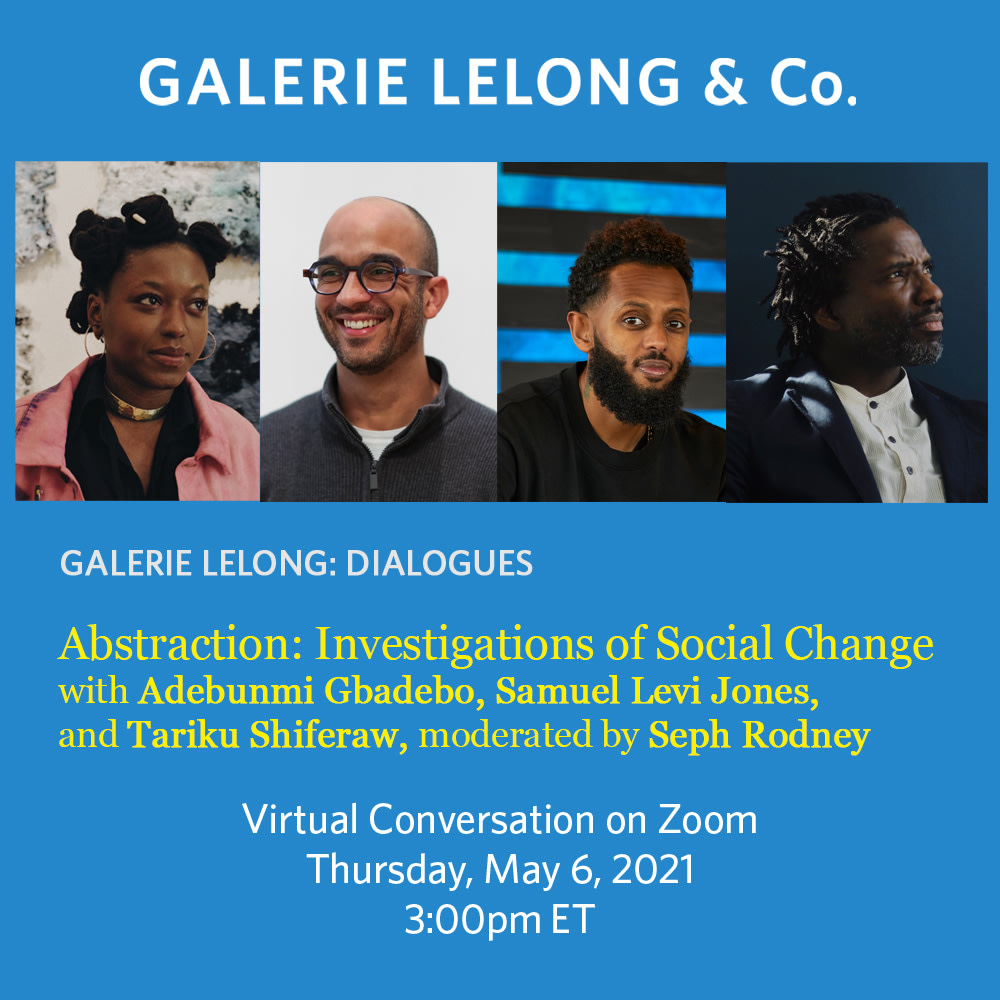
Join a conversation with artists Adebunmi Gbadebo, Samuel Levi Jones, and Tariku Shiferaw moderated by critic Seph Rodney on the embedding of social and political concerns within formal abstraction.
Gbadebo, Jones, and Shiferaw belong to a new generation of Black artists who are pushing the language of abstraction while retaining their cultural specificity; a movement that Rodney identified in a 2017 essay for Hyperallergic. Coming of age in a period when the consciousness of racial violence had reached a national scale, these artists address injustices toward minorities in their practices, charging their abstractions with a message for social change.
Adebunmi Gbadebo is a visual artist who creates sculptures, paintings, prints, and paper using human hair sourced from people of the African diaspora. Rejecting traditional art materials, Gbadebo saw hair as a means to center her people and their histories as central to the narratives in her work. Currently focused on her “True Blue series,” Gbadebo investigates the complexities around land, erasure, and value in the American south. Born in New Jersey and based in Newark, Gbadebo is a graduate of the School of Visual Arts, NY where she earned her BFA. Gbadebo’s work is in the permanent collection at the Smithsonian National Museum of African Art, the Smithsonian National Museum of African American History and Culture, the Minneapolis Institute of Art, and the Minnesota Museum of American Art, and the Newark Museum of Art. Gbadebo’s work has been presented in numerous exhibitions in the United States, Asia, and Europe, including the Dhaka Art Summit, Bangladesh; 1-54 Contemporary African Art Fair, London; Minneapolis Institute of Art, Minneapolis; Untitled Art Fair, Miami; Chashama, New York; Morris Art Dodge Foundation, New Jersey; College of Saint Elizabeth, New Jersey; Rutgers University, Newark amongst others. She has been written about in publications such as the New York Times, Hyperallergic, The Australian Sydney Morning Herald, Artspace, Ocula, Hypebeast, and Afropunk. Gbadebo is a current resident at the Clay Studio, Philadelphia, and a past resident at the Vermont Studio Center. She has been broadcasted on BBC Newsday and Talke TV (Nigeria) and has given talks at the Museum of the African Diaspora, Spence School, and the Newark Museum.
Samuel Levi Jones is inspired by questions of authority, representation, and recorded history. His ongoing practice centers on physically undoing objects associated with systems of power and control. Jones often rearranges deconstructed books into grid-like compositions that expose their flaws and question their assumed command of the truth. Museum exhibitions include Left of Center at the Indianapolis Museum of Art at Newfields, Indiana; Infinite Blue at the Brooklyn Museum; Solidary & Solitary: The Joyner/Guiffrida Collection at the Smart Museum at the University of Chicago; and Unbound at the Studio Museum in Harlem. His work can be found in museum and public collections such as the Chazen Museum of Art, University of Wisconsin – Madison; San Francisco Museum of Modern Art; Rubell Family Collection, Florida; Los Angeles County Museum of Art; the Studio Museum in Harlem; and the Whitney Museum of American Art, New York. Jones was born in Marion, Indiana, in 1978, and now lives and works between Chicago and Indianapolis, Indiana.
Tariku Shiferaw’s practice of mark-making references the historicity of abstract painting and its hierarchical structures embedded in scholarship. His current solo exhibition at Galerie Lelong, It’s a love thang, it's a joy thang (through May 15, 2021), draws inspiration from the ongoing movement of Black joy that has increasingly gained momentum among creatives as a source of community-building and healing. Shiferaw’s ongoing series of paintings One of These Black Boys references musical genres that have originated in black communities—Hip-hop, R&B, Reggae, Afrobeats, Blues, and Jazz—a context that charges the works with musical references, identities, and cultural histories. Shiferaw has participated in museum exhibitions at the Whitney Museum of American Art, New York, New York; Museum of Contemporary Art Cleveland, Ohio; Zuckerman Museum of Art (ZMA), Kennesaw, Georgia; Men of Change, a traveling exhibition organized by The Smithsonian Institution, and currently on view at the Anacostia Community Museum, Washington, DC and California African American Museum, Los Angeles; and What’s Love Got to Do with It? at The Drawing Center, New York, New York. Shiferaw has participated in the Independent Study Program at the Whitney Museum of American Art (Studio), in Open Sessions at The Drawing Center, and he was artist-in-residence at the LES Studio Program in New York City. Shiferaw is currently an artist-in-residence at the World Trade Center through Silver Art Projects. Shiferaw was born in Addis Ababa, Ethiopia, in 1983, raised in Los Angeles, California, and now lives and works in New York City.
Seph Rodney, PhD was born in Jamaica, and came of age in the Bronx, New York. He is the opinions editor for Hyperallergic, and writes on visual art and related issues. He has also written for The New York Times, CNN Op-ed pages, American Craft Magazine and NBC Universal, and penned catalog essays for Joyce J. Scott, Teresita Fernandez, and Meleko Mokgosi. He can be heard weekly on the podcast “The American Age.” His book, The Personalization of the Museum Visit, was published by Routledge in May of 2019. In 2020 he won the Rabkin Arts Journalism Prize.